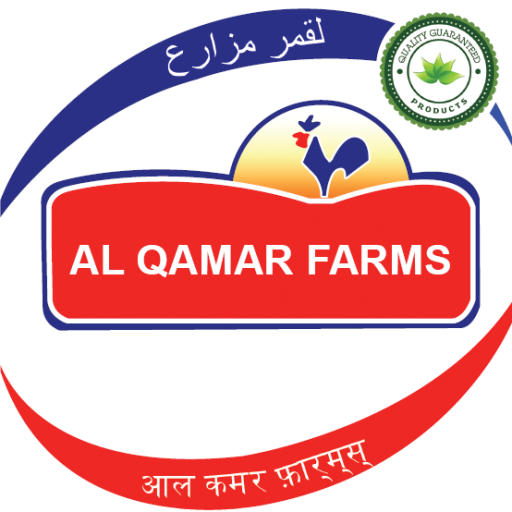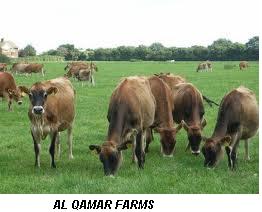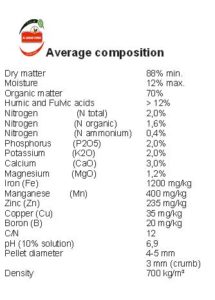ALQAMAR are associated with a group of quality auditors who check the offered lot on several parameters for ensuring quality compliance of the products. As ALQAMAR promise to offer quality approved products to the clients, ALQAMAR make use of only high-grade raw materials selected from one of the best sources present in the market.
Organic Fertilizer COW is a Fertilizer pellet that for a 100 percent is produced out of cow manure. These pelleted or granulated Fertilizer is easy to spread and dissolves quickly into the soil. This Organic Fertilizer can be packed in bags from 7,5 kg up to 20 kg, in big bags from 500 kg up to 1250 kg or is available in bulk or as a custom (private) label
Advantages
• Stimulates active development of the roots
• Balanced and gradual release of minerals
• No risk of burning roots, due to the absence of ammoniac and chlorine
• Doesn’t smell
Areas of application
• Vegetable Garden
• Lawns
• Roses and rose beds
• Ornamental cultivations
Types of Organic Fertilizers
Dry
Exactly what it says on the tin, dry fertilizers are often mixed into the soil. They can be used on both in-ground gardens and container grown plants. These types of fertilizer are generally added as a way of encouraging long-term growth in seedlings, transplants, and crops.
Liquid
Obviously, these fertilizers are nutrients in liquid form. They may additionally use a type of binding agent to help them be better absorbed by the plant in question. These fertilizers might be poured onto the soil surrounding the plant so that they can be absorbed roots. Or they could be sprayed on the leaves instead. After all, foliar (leaf) sprays are particularly useful for vegetables during their growing season.
Liquid fertilizers are generally considered good for plants that are actively growing and should usually be applied on a monthly basis. However, leafy crops might need to be sprayed on a biweekly basis.
Growth Enhancers
While they aren’t fertilizers per se, these substances help plants absorb nutrients that they receive from elsewhere. Some of them, such as kelp, are also a great source of trace elements. However, paying for these elements to be included in your fertilizer can be a waste of money since healthy soil should already contain helpful substances such as microbes, enzymes, and humic acids.
How to Use Organic Fertilizer
You pretty much use organic fertilizers in the same way you would use regular chemical fertilizer. If you are buying premade supplies, the process is fairly simple. Read the instructions on the box and err on the side of caution when you’re deciding how much to apply. (Hint: it’s always a good idea to avoid using strong smelling products like fish emulsion fertilizer indoors.)
However, if you want to mix up your own fertilizer for a specific garden need that you have, you can certainly do that as well. Just be careful not to overdo it in order to avoid burning or even killing sensitive plants.
List of Organic Fertilizers
Alfalfa Meal

NPK Ratio: 3-2-2
Alfalfa is commonly used as part of livestock feed. However, alfalfa meal is simply ground up so that it breaks down faster. This particular fertilizer has low amounts of nitrogen, phosphorus, and potassium. As a result, alfalfa meal works at moderate rate of speed. The best use for this fertilizer is as a soil conditioner in the early spring prior to planting crops.
Cottonseed Meal

NPK Ratio: 6-1-1
This fertilizer has plenty of nitrogen, but it also contains fair amounts of phosphorus and potassium. The downsides to cotton seed meal are that it works slowly and that it is available primarily in cotton growing areas. However, this fertilizer is particularly useful for conditioning gardens in the fall before cover crops are planted or before mulch is applied. This gives the cotton seed meal time to break down fully so that the nitrogen present is readily available in the spring.
Corn Gluten Meal

Corn gluten contains trace amounts of nitrogen, phosphorous, and potassium. It is also good soil stabilizer but it works slowly. Therefore, you should add it in the fall so that it has time to break down over the winter.
Rock Phosphate

NPK Ratio: 0-5-0
This fertilizer is made from rocks that have been ground up. It contains large amounts of phosphate as well as other essential nutrients. The main benefit of using rock phosphate is that the elements it contains don’t dissolve in water. Instead they hang around in the soil until they’re used by the plants that are growing there.
Cow Manure

Manure in general has a high mass to nutrients ratio. It nonetheless contains respectable amounts of nitrogen, phosphorus, and potassium. Cow manure also works on gardens at a moderate rate of speed. These elements all help to make it an excellent compost additive. However, some weed seeds may survive being digested by the cows in question and this can cause obvious problems. You should also avoid manure leftover from industrial operations because it contains lots of salt. However, even regular manure can end up burning plants if too much is used or if it’s used too often.
Chicken or Poultry Manure

chicken manure source
NPK Ratio: 3.5-1.5-1.5
Having a lot of poultry crap on hand doesn’t mean that you’ll get comparatively high nutrient levels. Even so, this fertilizer contains slightly higher amounts of the three main plant nutrients than cow manure does. It’s also works in a somewhat faster fashion. The best time to use poultry manure is just after harvesting your crops or just before you begin another gardening cycle. As is the case with cow manure, you’ll want to be careful with this product because it can burn your plants if too much is applied.
Earthworm Castings

NPK Ratio: 2-1-1
Earthworm casings contain decent amounts of all three vital nutrients. As a result, this type of fertilizer is considered a great addition to flower and vegetable gardens.
Greensand

NPK Ratio: 1-1-5
Greensand comes from ancient sea beds. This high calcium fertilizer also contains iron, potassium, and other trace elements. However, the nutrient levels in greensand products can vary depending on their source.
Compost

Compost’s nutrient profile varies based on what is put into but it is often close to that of cow manure. It is a popular garden fertilizer. This is no doubt because it can be made for free and it works at a moderate pace. There are also a variety of ways that compost can be used in your garden. It can be used as a mulch or mixed with your garden soil. It can also be brewed into compost tea to use as a foliar feed. Gardeners who don’t have space for a large compost system can even get similar benefits from using worm compost bins under their sinks.
However, compost can be alkaline in nature. This characteristic negatively affects how well plants living in the soil can absorb nutrients. Compost also has a high weight to available nutrient ratio. Improperly tended compost pile can additionally emit bad smells, which can quickly get city dwellers in trouble with their neighbors.
If you still plan on using it, compost should be added before or after planting. It’s also a good soil refresher in between growing seasons for gardens that are constantly in use. You’ll want to use half an inch to a full inch every time a new crop is planted.
Soybean Meal

NPK Ratio: 7-2-0
Soybean meal is high nitrogen fertilizer that also contains low amounts of phosphorus and calcium. Local growing conditions tend to affect how fast this product is absorbed into the soil but this process normally occurs at moderate rates of speed. However, soybean meal is fairly useful as a long term soil conditioner.
Blood Meal

NPK Ratio: 12-1.5-0.5
This fertilizer is created from the powdered blood of butchered livestock. While it is high in nitrogen, blood meal is low in other elements. It is also highly acidic and likely to burn plants if too much is used at one time. You should definitely proceed with caution. It’s best to apply blood meal to the soil before planting anything in it. Even so, blood meal’s fast-acting nature makes it a good tonic for ailing plants. You will need to pour this fertilizer over the plants roots according to the package directions and then possibly cover everything up with mulch.
Bone Meal

It’s no surprise that bone meal is made from ground up cow bones. This high phosphorous fertilizer also contains plenty of nitrogen. Bone meal works at moderate speeds to encourage flower production and root growth. As a result, it is great for flowering plants, bulbs, and fruit trees. However, bone meal is mostly used as a soil amendment for spots with high nitrogen levels where plants keep getting burned.
Feather Meal

NPK Ratio: 12-0-0
Feather meal is very high in nitrogen. However, it doesn’t contain any calcium or phosphorus and it only works at moderate speeds. If you plan on using this fertilizer in your yard, use it prior to planting in order to give the soil a nutrient boost.
Seabird Guano
NPK Ratio: 10-10-2
Seabird guano is gathered from islands that have low rainfall and arid climates, both factors which help it retain high levels of nutrients. Seabird guano contains large levels of trace elements along with decent amounts of nitrogen, phosphorus, and calcium. In fact, it is considered to be among the world’s best organic fertilizers.
Bat Guano

NPK Ratio: 10-10-2
Bat guano is a fast-acting fertilizer that contains a wide variety of nutrients such as nitrogen, phosphorus, calcium, and various other minerals. It is not as high in these components as seabird guano but it is more readily available. Since some of the nutrients contained in bat guano are water-soluble, this fertilizer is probably at its most effective when used as a foliar spray or a compost tea. You can also apply it between crop plantings and as a soil refresher in the late spring.
Fish Meal

Due to its high nitrogen levels, fish meal is a fairly fast acting fertilizer. It also has decent amounts of phosphorus and calcium. It is good for corn crops.
Fish Emulsion

NPK Ratio: 2-4-0 to 5-1-1
This product is made from partially decomposed fish. As a result, it often has a bad odor. Fish emulsion fertilizer is high in nitrogen but it contains no calcium or potassium. It is also very acidic and should be used lightly to avoid burning plants. Fish emulsion nonetheless acts immediately once it is applied, which makes it a good treatment for leafy species that are suffering from low nitrogen levels. However, some plants may not tolerate it very well.
Shellfish Fertilizer / Shell Meal

This fertilizer is made from crushed up seafood byproducts. It contains plenty of calcium and some phosphorous as well as a large quantity of trace minerals. Shell meal also contains an element called chitin, which helps ward off pesky nematodes.
Liquid Kelp Fertilizer

This is a kelp based fertilizer created by cold processing. Kelp contains small amounts of the main three fertilizer components but it’s quite high in trace elements. It is also a good source of growth hormones that can help plants reach their full potential. This liquid fertilizer is typically mixed with water and used as a foliar spray or poured into the soil around plants.
Seaweed

NPK Ratio: 1.5-0.75-5
Seaweed is a fast acting fertilizer that’s often available for free along most coastlines. It contains all of the major three nutrients in small amounts but also contains plenty of zinc and iron. Seaweed is considered highly beneficial to grain crops as well as those that need high levels of potassium.
Grass Clippings

NPK Ratio: 1-0-1.2
It’s hard to beat grass clippings as a low cost fertilizer since they’re usually free. This substance can be used to prevent weeds and conserve moisture in the soil. However, the nitrogen content in each batch varies. A layer of 1 to 2 inches should be sufficient for a full growing season. Just don’t use cuttings from lawns that have been grown using herbicides.
homemade organic fertilizer types of organic fertilizers list of organic fertilizers advantages of organic fertilizers organic fertilizer examples homemade organic fertilizer for vegetables organic tomato fertilizer homemade organic soil amendments and fertilizers





